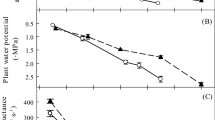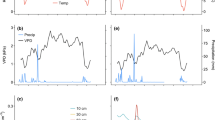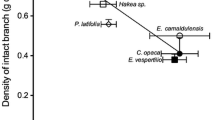Abstract
In the European Alps, Rhododendron ferrugineum grows in silicate regions while Rhododendron hirsutum is restricted to limestone areas. At geologically mixed sites, also hybrids (Rhododendron × intermedium) can occur. We hypothesised that hydraulic properties would vary with the species’ habitat requirements. Key hydraulic parameters (vulnerability to drought-induced embolism, stomata regulation) and related wood characteristics as well as diurnal courses of water potential (Ψ) and stomatal conductance were analysed on plants growing on a silicate, a limestone and a geologically mixed site. Highest embolism resistance[Ψ at 50% loss of conductivity (Ψ 50), −3.24 ± 0.18 MPa] and the highest safety margin between the Ψ at stomata closure (Ψ SC at 10% of maximal leaf conductance) and Ψ 50 were observed in R. hirsutum at the limestone site (1.57 MPa). Like in R. ferrugineum, hydraulic parameters indicated less resistance at the geologically mixed site. Highest Ψ 50 (−1.95 ± 0.12 MPa), corresponding to wide conduits and a reduced conduit wall reinforcement, was found in R. × intermedium. Diurnal courses indicated a rapid stomata closure in response to low Ψ in R. hirsutum and R. × intermedium. The plasticity in drought adaptation of R. hirsutum corresponds to its ability to colonise dry limestone areas. In contrast, hydraulic limitations of R. × intermedium may explain restrictions to rather moist sites. This study provides insight into the role of xylem hydraulics and stomata regulation in shrub water relations, interspecific and site-specific differences in drought adaptation, as well as effects of hybridisation on plant hydraulics.



Similar content being viewed by others
References
Alder NN, Sperry JS, Pockman WT (1996) Root and xylem embolism, stomatal conductance, and leaf turgor in Acer grandidentatum populations along a soil moisture gradient. Oecologia 105:293–301
Beikircher B, Mayr S (2009) Intraspecific differences in drought tolerance and acclimation in hydraulics of Ligustrum vulgare L. and Viburnum lantana L. Tree Physiol 29:765–775
Boehm H (1893) Capillarität und Saftsteigen. Ber Dtsch Bot Ges 11:203–212
Breda N, Huc R, Granier A, Dreyer E (2006) Temperate forest trees and stands under severe drought: a review of ecophysiological responses, adaptation processes and long-term consequences. Ann For Sci 63:625–644
Brodribb TJ (2009) Xylem hydraulic physiology: the functional backbone of terrestrial plant productivity. Plant Sci 177:245–251
Brodribb T, Hill RS (1999) The importance of xylem constraints in the distribution of conifer species. New Phytol 143:365–372
Choat B, Sack L, Holbrook NM (2007) Diversity of hydraulic traits in nine Cordia species growing in tropical forests with contrasting precipitation. New Phytol 175:686–698
Cochard H, Bréda N, Granier A, Aussenac G (1992) Vulnerability to air embolism of three European oak species (Quercus petraea (Matt) Liebl, Q. pubescens Willd, Q. robur L). Ann For Sci 49:225–233
Cochard H, Bréda N, Granier A (1996) Whole tree hydraulic conductance and water loss regulation in Quercus during drought: evidence for stomatal control of embolism. Ann For Sci 53:197–206
Cochard H, Lemoine D, Dreyer E (1999) The effects of acclimation to sunlight on the xylem vulnerability to embolism in Fagus sylvatica L. Plant Cell Environ 22:101–108
Cochard H, Coll L, Le Roux X, Ameglio T (2002) Unraveling the effects of plant hydraulics on stomatal closure during water stress in walnut. Plant Physiol 128:282–290
Cochard H, Casella E, Mencuccini M (2007) Xylem vulnerability to cavitation varies among poplar and willow clones and correlates with yield. Tree Physiol 27:1761–1767
Cordero RA, Nilsen ET (2002) Effects of summer drought and winter freezing on stem hydraulic conductivity of Rhododendron species from contrasting climates. Tree Physiol 22:919–928
Crombie DS, Milburn JA, Hipkins MF (1985) Maximum sustainable xylem sap tensions in Rhododendron and other species. Planta 163:27–33
Fischer MA, Oswald K, Adler W (2008) Exkursionsflora für Österreich, Liechtenstein, Südtirol, 2nd edn. Biologiezentrum der Oberösterreichischen Landesmuseen, Linz
Hacke U, Sperry JS, Pittermann J (2000) Drought experience and cavitation resistance in six shrubs from the Great Basin, Utah. Basic Appl Ecol 1:31–41
Hacke UG, Sperry JS, Pockman WT, Davis SD, McCulloh KA (2001) Trends in wood density and structure are linked to prevention of xylem implosion by negative pressure. Oecologia 126:457–461
Hacke UG, Sperry JS, Pittermann J (2004) Analysis of circular bordered pit function II. Gymnosperm tracheids with torus-margo pit membranes. Am J Bot 91:386–400
Hacke UG, Sperry JS, Wheeler JK, Castro L (2006) Scaling of angiosperm xylem structure with safety and efficiency. Tree Physiol 26:689–701
Hacke UG, Jacobsen AL, Pratt RB (2009) Xylem function of aridland shrubs from California, USA: an ecological and evolutionary analysis. Plant Cell Environ 32:1324–1333
Hubbard RM, Ryan MG, Stiller V, Sperry JS (2001) Stomatal conductance and photosynthesis vary linearly with plant hydraulic conductance in ponderosa pine. Plant Cell Environ 24:113–121
Jones HG, Sutherland RA (1991) Stomatal control of xylem embolism. Plant Cell Environ 14:607–612
Kolb KJ, Sperry JS (1999) Differences in drought adaptation between subspecies of sagebrush (Artemisia tridentata). Ecology 80:2373–2384
Körner C (2003) Alpine plant life, 2nd edn. Springer, Berlin
Larcher W (1972) Der Wasserhaushalt immergrüner Pflanzen im Winter. Ber Dtsch Bot Ges 85:315–327
Larcher W, Siegwolf R (1985) Development of acute frost drought in Rhododendron ferrugineum at the alpine timberline. Oecologia 67:298–300
Larcher W, Wagner J (2004) Plant life of alpine rhododendrons in their environment: seventy years of ecological research in Innsbruck. Nat Med Ver Innsbruck 91:251–291
Lipp CC, Nilsen ET (1997) The impact of subcanopy light environment on the hydraulic vulnerability of Rhododendron maximum to freeze-thaw cycles and drought. Plant Cell Environ 20:1264–1272
Martínez-Vilalta J, Prat E, Oliveras I, Piñol J (2002) Xylem hydraulic properties of roots and stems of nine Mediterranean woody species. Oecologia 133:19–29
Mayr S (2007) Limits in water relations. In: Wieser G, Tausz M (eds) Trees at their upper limit. Treelife limitation at the alpine timberline. Springer, Berlin, pp 145–162
Mayr S, Wolfschwenger M, Bauer H (2002) Winter-drought induced embolism in Norway spruce (Picea abies) at the alpine timberline. Physiol Plant 115:74–80
Mayr S, Gruber A, Bauer H (2003a) Repeated freeze-thaw cycles induce embolism in drought stressed conifers (Norway spruce, stone pine). Planta 217:436–441
Mayr S, Schwienbacher F, Bauer H (2003b) Winter at the alpine timberline: why does embolism occur in Norway spruce but not in stone pine? Plant Physiol 131:780–792
Mayr S, Hacke U, Schmid P, Schwienbacher F, Gruber A (2006) Frost drought in conifers at the alpine timberline: xylem dysfunction and adaptations. Ecology 87:3175–3185
Pammenter NW, Vander Willigen C (1998) A mathematical and statistical analysis of the curves illustrating vulnerability of xylem to cavitation. Tree Physiol 18:589–593
Pisek A, Larcher W (1954) Zusammenhang zwischen Austrocknungsresistenz und Frosthärte bei Immergrünen. Protoplasma 44:30–46
Pittermann J, Sperry JS (2003) Tracheid diameter is the key trait determining the extent of freezing-induced embolism in conifers. Tree Physiol 23:907–914
Pittermann J, Sperry JS (2006) Analysis of freeze-thaw embolism in conifers. The interaction between cavitation pressure and tracheid size. Plant Physiol 140:374–382
Pockman WT, Sperry JS (2000) Vulnerability to xylem cavitation and the distribution of Sonoran Desert vegetation. Am J Bot 87:1287–1299
Polatschek A (1999) Flora von Nordtirol, Osttirol und Vorarlberg. Band 2. Tiroler Landesmuseum Ferdinandeum, Innsbruck
Poudyal K, Jha PK, Zobel DB, Thapa CB (2004) Patterns of leaf conductance and water potential of five Himalayan tree species. Tree Physiol 24:689–699
Saliendra NZ, Sperry JS, Comstock JP (1995) Influence of leaf water status on stomatal response to humidity, hydraulic conductance, and soil drought in Betula occidentalis. Planta 196:357–366
Sperry JS (2004) Coordinating stomatal and xylem functioning—an evolutionary perspective. New Phytol 162:568–570
Sperry JS, Hacke UG (2002) Desert shrub water relations with respect to soil characteristics and plant functional type. Funct Ecol 16:367–378
Sperry JS, Hacke UG (2004) Analysis of circular bordered pit function. I. Angiosperm vessels with homogenous pit membranes. Am J Bot 91:369–385
Sperry JS, Donnelly JR, Tyree MT (1988) A method for measuring hydraulic conductivity and embolism in xylem. Plant Cell Environ 11:35–40
Sperry JS, Hacke UG, Oren R, Comstock JP (2002) Water deficits and hydraulic limits to leaf water supply. Plant Cell Environ 25:251–263
Sperry JS, Hacke UG, Field TS, Sano Y, Sikkema EH (2007) Hydraulic consequences of vessel evolution in angiosperms. Int J Plant Sci 168:1127–1139
Taschler D, Beikircher B, Neuner G (2004) Frost resistance and ice nucleation in leaves of five woody timberline species measured in situ during shoot expansion. Tree Physiol 24:331–337
Tranquillini W (1969) Photosynthese und Transpiration einiger Holzarten bei verschieden starkem Wind. Cbl Ges Forstw 86:35–48
Tranquillini W (1976) Water relations and alpine timberline. In: Lange OL, Kappen L, Schulze ED (eds) Water and plant life. Ecological Studies vol 19. Springer, Berlin, pp 473–491
Tutin TG, Heywood VH, Burges NA, Moore DM, Valentine DH, Walters SM, Webb DA (1972) Flora Europaea, vol 3. Cambridge University Press, Cambridge
Tyree MT, Ewers FW (1991) The hydraulic architecture of trees and other woody plants. New Phytol 119:345–360
Tyree MT, Sperry JS (1988) Do woody plants operate near the point of catastrophic xylem dysfunction caused by dynamic water stress? Plant Physiol 88:574–580
Tyree MT, Zimmermann MH (2002) Xylem structure and the ascent of sap. Springer, Berlin
Tyree MT, Davis SD, Cochard H (1994) Biophysical perspectives of xylem evolution: is there a tradeoff of hydraulic efficiency for vulnerability to dysfunction? IAWA J 15:335–360
Wheeler JK, Sperry JS, Hacke UG, Hoang N (2005) Inter-vessel pitting and cavitation in woody Rosaceae and other vesselled plants: a basis for a safety versus efficiency trade-off in xylem transport. Plant Cell Environ 28:800–812
Acknowledgments
This study was supported by APART (Austrian programme for advanced research and technology) and the Fonds zur Förderung der Wissenschaftlichen Forschung (FWF). We thank Mag. Ing. Birgit Dämon for excellent assistance. We also thank Prof. Heilmeier and the anonymous reviewers for thoughtful comments which helped to improve the manuscript.
Author information
Authors and Affiliations
Corresponding author
Additional information
Communicated by Hermann Heilmeier.
Rights and permissions
About this article
Cite this article
Mayr, S., Beikircher, B., Obkircher, MA. et al. Hydraulic plasticity and limitations of alpine Rhododendron species. Oecologia 164, 321–330 (2010). https://doi.org/10.1007/s00442-010-1648-7
Received:
Accepted:
Published:
Issue Date:
DOI: https://doi.org/10.1007/s00442-010-1648-7




